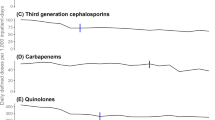Abstract
Misuse of antibiotics can provoke increased bacterial resistance. There are no immediate prospects of any new broad-spectrum antibiotics, especially any with activity against enterobacteria, coming onto the market. Therefore, programmes should be implemented to optimise antimicrobial therapy. In a quasi-experimental study, the results for the pre-intervention year were compared with those for the 3 years following the application of an antimicrobial stewardship programme. We describe 862 interventions carried out as part of the stewardship programme at the Hospital Costa del Sol from 2009 to 2011. We examined the compliance of the empirical antimicrobial treatment with the programme recommendations and the treatment optimisation achieved by reducing the antibiotic spectrum and adjusting the dose, dosing interval and duration of treatment. In addition, we analysed the evolution of the sensitivity profile of the principal microorganisms and the financial savings achieved. 93 % of the treatment recommendations were accepted. The treatment actions taken were to corroborate the empirical treatment (46 % in 2009 and 31 % in 2011) and to reduce the antimicrobial spectrum taking into account the antibiogram results (37 % in 2009 and 58 % in 2011). The main drugs assessed were imipenem/meropenem, used in 38.6 % of the cases, and cefepime (20.1 %). The sensitivity profile of imipenem against Pseudomonas aeruginosa increased by 10 % in 2011. Savings in annual drug spending (direct costs) of 30,000 Euros were obtained. Stewardship programmes are useful tools for optimising antimicrobial therapy. They may contribute to preventing increased bacterial resistance and to reducing the long-term financial cost of antibiotic treatment.
Similar content being viewed by others
References
Rodríguez-Baño J, Alcalá JC, Cisneros JM et al (2008) Community infections caused by extended-spectrum beta-lactamase-producing Escherichia coli. Arch Intern Med 168(17):1897–1902
Arias CA, Murray BE (2009) Antibiotic-resistant bugs in the 21st century—a clinical super-challenge. N Engl J Med 360:439–443
Spellberg B, Guidos R, Gilbert D et al (2008) The epidemic of antibiotic-resistant infections: a call to action for the medical community from the Infectious Diseases Society of America. Clin Infect Dis 46:155–164
Bartlett JG, Gilbert DN, Spellberg B (2013) Seven ways to preserve the miracle of antibiotics. Clin Infect Dis 56(10):1445–1450
Paterson DL (2006) The role of antimicrobial management programs in optimizing antibiotic prescribing within hospitals. Clin Infect Dis 42:S90–S95
Cobo Reinoso J, Oliva Domínguez J, Soler Vigil M et al (2002) Evaluation of an advisory program in antibiotic therapy. Rev Clin Esp 202:78–83
López-Medrano F, San Juan R, Serrano O et al (2005) Impact of a non-compulsory antibiotic control program (PACTA): cost reductions and decreases in some nosocomial infections. Enferm Infecc Microbiol Clin 23:186–190
Ramos Martínez A, Muñez Rubio E, Santiago Pérez A et al (2007) Antibiotic treatment optimization by means of antibiotic treatment experts participation. An Med Interna 24:375–378
del Arco A, Tortajada B, de la Torre J et al (2011) Results of a counselling programme in antibiotic treatment in a secondary hospital. Rev Esp Quimioter 24(2):96–98
Gil-Navarro MV, Muñoz-Corte R, Herrero Romero M et al (2009) Work of a multidisciplinary team in the control of the prescription of ertapenem. Farm Hosp 33:48–52
MacDougall C, Polk RE (2005) Antimicrobial stewardship programs in health care systems. Clin Microbiol Rev 18:638–656
Dryden M, Johnson AP, Ashiru-Oredope D et al (2011) Using antibiotics responsibly: right drug, right time, right dose, right duration. J Antimicrob Chemother 66:2441–2443
Rice L (2008) The Maxwell Finland Lecture: for the duration-rational antibiotic administration in an era of antimicrobial resistance and Clostridium difficile. Clin Infect Dis 46:491–496
Murray C, Shaw A, Lloyd M et al (2014) A multidisciplinary intervention to reduce antibiotic duration in lower respiratory tract infections. J Antimicrob Chemother 69:515–518
Drew RH (2009) Antimicrobial stewardship programs: how to start and steer a successful program. J Manag Care Pharm 15(Suppl):S18–S23
Rodríguez-Baño J, Paño-Pardo JR, Alvarez-Rocha L et al (2012) Programs for optimizing the use of antibiotics (PROA) in Spanish hospitals: GEIH-SEIMC, SEFH and SEMPSPH consensus document. Enferm Infecc Microbiol Clin 30(1):22.e1–22.e23
Kollef MH (2008) Broad-spectrum antimicrobials and the treatment of serious bacterial infections: getting it right up front. Clin Infect Dis 47:S3–S13
Morel J, Casoetto J, Jospé R et al (2010) De-escalation as part of a global strategy of empiric antibiotherapy management. a retrospective study in a medico-surgical intensive care unit. Crit Care 14(6):R225
Cisneros JM, Neth O, Gil-Navarro MV et al (2014) Global impact of an educational antimicrobial stewardship programme on prescribing practice in a tertiary hospital centre. Clin Microbiol Infect 20(1):82–88
Conflict of interest
The authors declare that they have no conflict of interest.
Author information
Authors and Affiliations
Corresponding author
Rights and permissions
About this article
Cite this article
del Arco, A., Tortajada, B., de la Torre, J. et al. The impact of an antimicrobial stewardship programme on the use of antimicrobials and the evolution of drug resistance. Eur J Clin Microbiol Infect Dis 34, 247–251 (2015). https://doi.org/10.1007/s10096-014-2225-5
Received:
Accepted:
Published:
Issue Date:
DOI: https://doi.org/10.1007/s10096-014-2225-5




